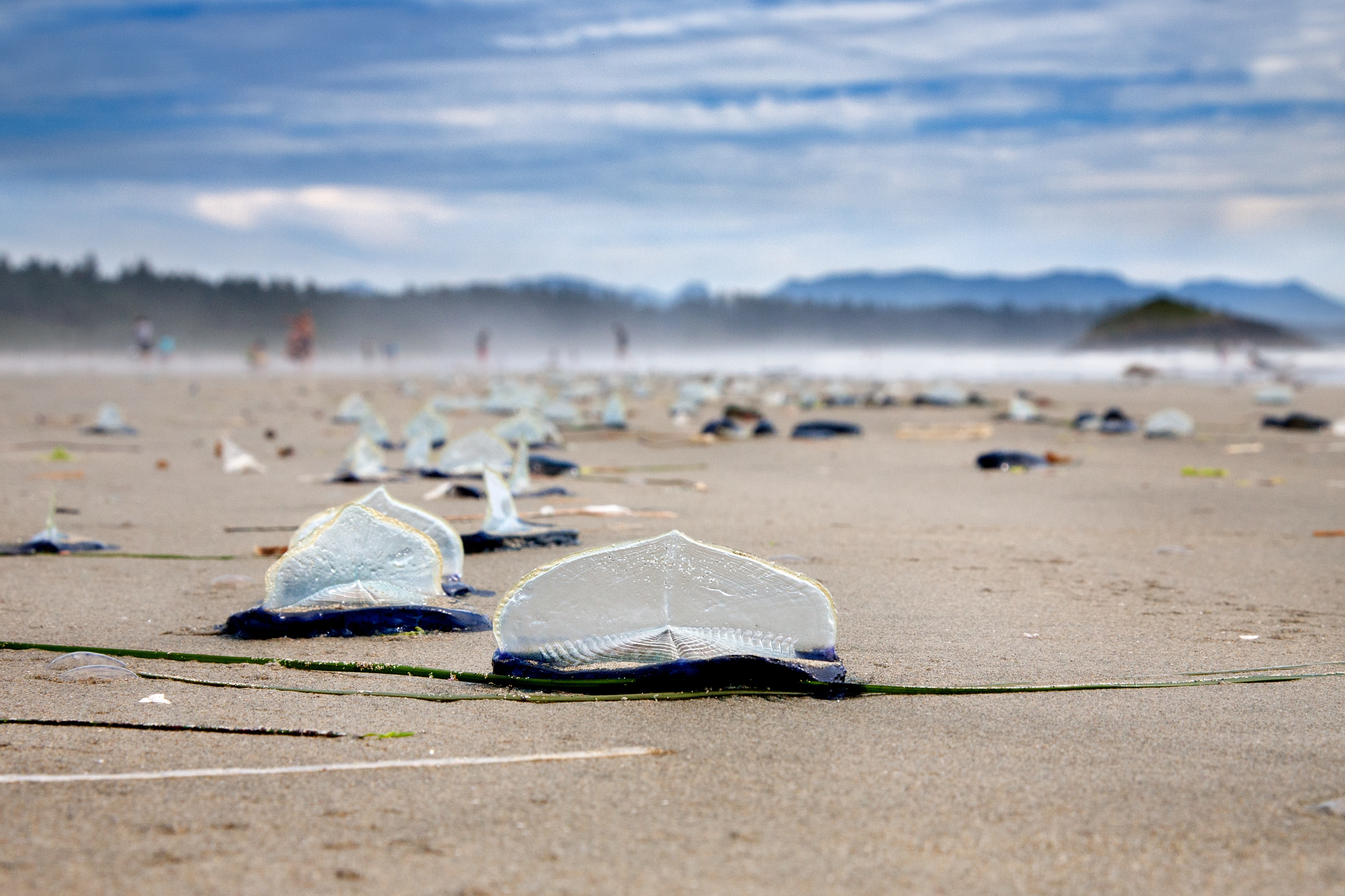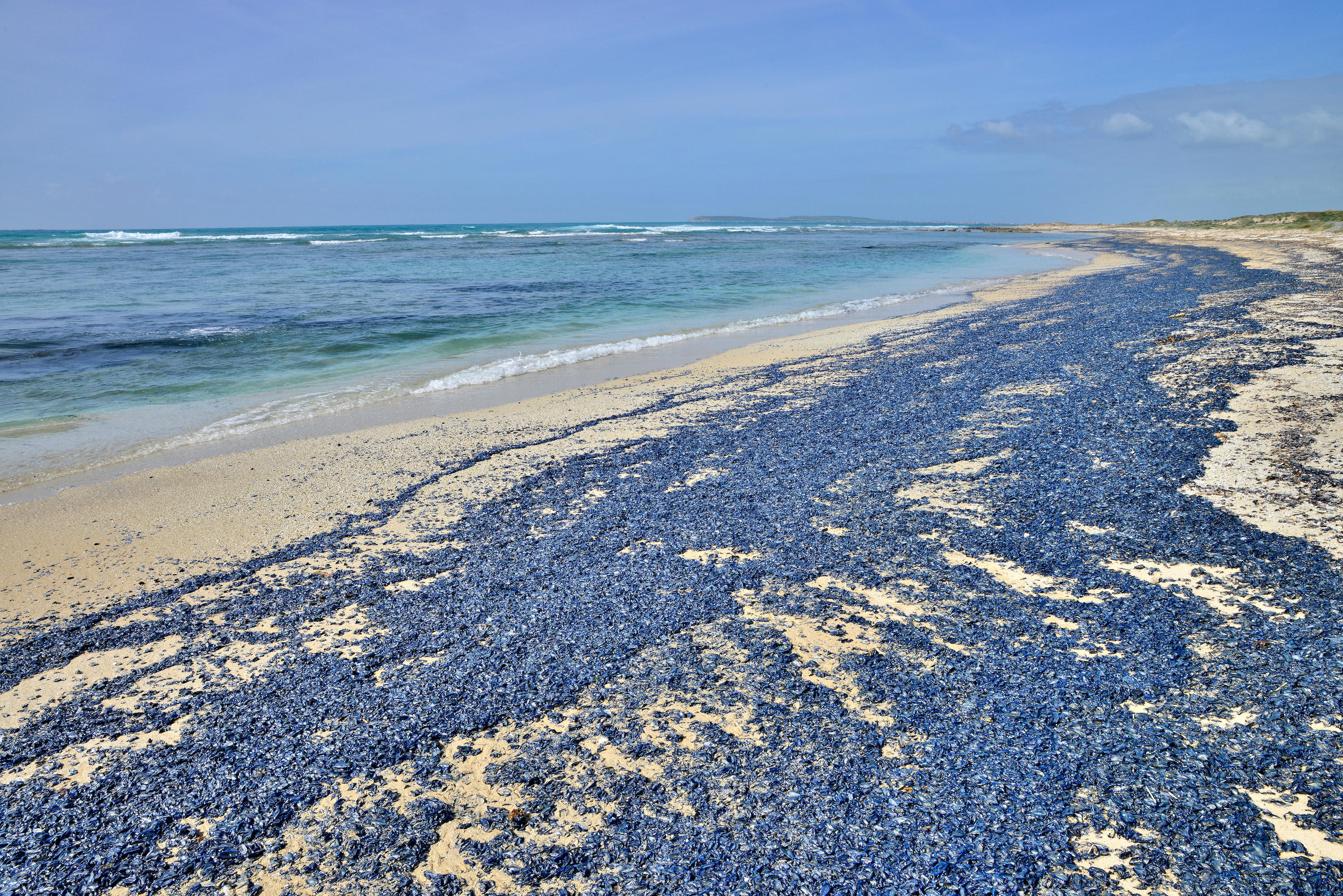Millions of dead jellyfish are washing up around the world. 'The blob' could be to blame.
The dead jellies form a 'crunchy carpet' of corpses, one expert said.

Like a tourist on a cruise ship, the by-the-wind sailor jellyfish (Velella velella) spends its days drifting aimlessly through the open sea, gorging itself on an endless buffet of complementary morsels.
The jelly straddles the ocean's surface with a rigid sail poking just above the water and an array of purple tentacles dangling just underneath. As the sail catches wind, the jelly floats from place to place, capturing tiny fish and plankton wherever it roams. Thriving Velella colonies can include millions of individuals, all just partying and chowing down together in the open water. Life is good.
Until, that is, the wind blows a colony of sailor jellies onto shore.
Every year, on beaches around the world, colonies of sailor jellies become stranded by the thousands. There, they dry up and die, becoming a "crunchy carpet" of dehydrated corpses covering the sand, Julia Parrish, a University of Washington professor and co-author of a new study on mass Velella strandings, said in a statement.
Related: Image gallery: Jellyfish rule!
Sailor jelly strandings are common when seasonal winds change course, but some — like a 2006 event on the west coast of New Zealand — are on another level entirely, with the jellyfish corpses numbering not in the thousands, but in the millions. Why? What force of nature makes some Velella strandings so much larger than others?
Parrish and her colleagues wanted to find out. So, in their new study (published March 18 in the journal Marine Ecology Progress Series) they delved into 20 years of Velella observations reported along the west coast of the United States.
Get the world’s most fascinating discoveries delivered straight to your inbox.
The observations came from a program called the Coastal Observation and Seabird Survey Team, also known as COASST, which trains citizen scientists to search their local beaches for marine birds that have washed ashore, plus any other unusual animal sightings. COASST's network covers hundreds of beaches stretching from northern California to the Arctic Circle, according to the group's website — and, of course, some members have had run-ins with Velella.
The researchers found nearly 500 reports of Velella strandings in the COASST database, sighted on nearly 300 beaches. According to these reports, the most massive die-offs by far occurred during spring months from 2015 to 2019. During those years, dead jellyfish littered more than 620 miles (1,000 kilometers) of continuous coastline, the researchers found.
Those jellyfish die-offs also coincided with a massive marine heat wave known as "the blob." Beginning in 2013, surface waters off the Pacific coast began heating up to levels never recorded before, Live Science previously reported. The intense warming continued through 2016, tampering with every level of the marine food chain and resulting in mass die-offs of seabirds, baleen whales, sea lions and other creatures. According to the new study, it's likely that the blob drove the mass die-offs of by-the-wind sailor jellyfish reported during those years.
The catch is, those warming ocean waters may have actually been good for the jellies, the researchers said. As the blob increased ocean surface temperatures, certain fish (such as northern anchovies) benefited from longer spawning seasons, providing more food for Velella jellies to gobble up earlier in the year. This may have caused jellyfish populations to spike before seasonal wind changes blew the jellies ashore in the spring.
In other words, the blob may have helped Velella jellies thrive off the Pacific coast, leading to much larger stranding events those years. The sailor jellies could therefore become climate change "winners" as global warming is predicted to increase the frequency of marine heat waves, the researchers wrote. But their success will come at the expense of other, less fortunate creatures — and a whole mess of jellyfish carcasses on our coasts.
"A changing climate creates new winners and losers in every ecosystem," Parrish said in the statement. "What's scary is that we're actually documenting that change."
Originally published on Live Science.

Brandon is the space / physics editor at Live Science. With more than 20 years of editorial experience, his writing has appeared in The Washington Post, Reader's Digest, CBS.com, the Richard Dawkins Foundation website and other outlets. He holds a bachelor's degree in creative writing from the University of Arizona, with minors in journalism and media arts. His interests include black holes, asteroids and comets, and the search for extraterrestrial life.



